History
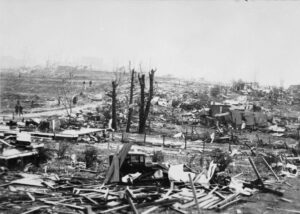 Tornadoes are a common storm in some parts of the United States. The most common area for them is called Tornado Alley. Usually, when storms go through, you might hear of tornado watches. That doesn’t mean that there are multiple tornadoes in an area, but it could. In 1936, beginning on April 5th and extending through April 6th, the states of Mississippi and Georgia found themselves in the middle of a tornado outbreak, which is several tornadoes in an area, of course. This is the only continuous tornado outbreak in United States history to produce more than one tornado with triple digit death tolls. Also, severe flash floods from the associated storms caused millions of dollars in damage across the region.
Tornadoes are a common storm in some parts of the United States. The most common area for them is called Tornado Alley. Usually, when storms go through, you might hear of tornado watches. That doesn’t mean that there are multiple tornadoes in an area, but it could. In 1936, beginning on April 5th and extending through April 6th, the states of Mississippi and Georgia found themselves in the middle of a tornado outbreak, which is several tornadoes in an area, of course. This is the only continuous tornado outbreak in United States history to produce more than one tornado with triple digit death tolls. Also, severe flash floods from the associated storms caused millions of dollars in damage across the region.
The storm, called the Tupelo-Gainesville Outbreak, produced at least 12 tornadoes. The outbreak took place over two days, April 5th and 6th, but was really just about 12 hours in duration. The storm hit Tupelo, Mississippi at 8:30pm on April 5, 1936. It was the fourth-deadliest tornado in United States history. The storm came out of a group of storm cells, and first touched down in a rural area about eight miles from the city. The twister killed a family of 13, sweeping their house away as the tornado made its way toward Tupelo. Many more were injured before it even reached the city. The tornado was retroactively rated an F5 on the Fujita scale, it caused total destruction along its path through the Willis Heights neighborhood. In that area were a number of well-built large mansions that were blown away like a house of cards.
The tornado missed the business district, and instead hit residential areas, sadly…increasing the death toll. The Gum Pond area of Tupelo was the worst hit. Homes along the pond were swept into the water with their 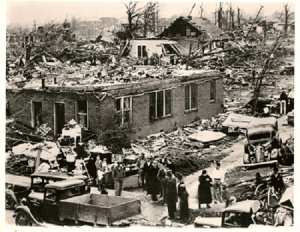 victims. The majority of the bodies were found in Gum Pond, the area which is now Gumtree Park, but many bodies were never recovered from the pond at all. The winds were so strong, that pine needles were embedded into trunks of trees. The tornado took out the large concrete Battle of Tupelo monument as it exited the city’s east side. According to records, the Tupelo tornado leveled 48 city blocks and between 200 and 900 homes. It officially killed at least 216 people and injured at least 700. The tornado destroyed the water tower and produced numerous fires in its wake. Thankfully, overnight rains, which left knee-deep water in some streets put out the fires. Though 216 remained the final death toll, 100 persons were still hospitalized at the time it was set. Subsequently, the Mississippi State Geologist estimated a final, unofficial death toll of 233. Surprisingly, one-year-old Elvis Presley and his parents were among the survivors, a fact I never knew about him.
victims. The majority of the bodies were found in Gum Pond, the area which is now Gumtree Park, but many bodies were never recovered from the pond at all. The winds were so strong, that pine needles were embedded into trunks of trees. The tornado took out the large concrete Battle of Tupelo monument as it exited the city’s east side. According to records, the Tupelo tornado leveled 48 city blocks and between 200 and 900 homes. It officially killed at least 216 people and injured at least 700. The tornado destroyed the water tower and produced numerous fires in its wake. Thankfully, overnight rains, which left knee-deep water in some streets put out the fires. Though 216 remained the final death toll, 100 persons were still hospitalized at the time it was set. Subsequently, the Mississippi State Geologist estimated a final, unofficial death toll of 233. Surprisingly, one-year-old Elvis Presley and his parents were among the survivors, a fact I never knew about him.
After ravaging Tupelo, the storm system moved through Alabama overnight and reached Gainesville, Georgia, at around 8:30am. When the storm hit Gainesville, it became a double tornado event. One tornado moved in from the Atlanta highway, while the other moved in from the Dawsonville highway. As they came into town, the two tornadoes then merged into one on Grove Street and destroyed everything throughout the downtown area…leaving 10 foot high piles of debris in some places. The worst tornado-caused death toll in a single building in United States history was at the Cooper Pants Factory. The multiple-story building was then filled with young workers, who had just arrived to work. The structure collapsed and caught fire, killing about 70 people. At the Pacolet Mill, 550 workers moved to the northeast side of the building and survived. Many people sought refuge in Newman’s department store, and its collapse killed 20 people. In addition to the complete destruction that occurred throughout downtown Gainesville, residential areas throughout the city were 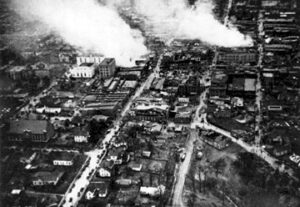 devastated as well, where 750 homes were destroyed, and 254 others were badly damaged.
devastated as well, where 750 homes were destroyed, and 254 others were badly damaged.
The Tupelo-Gainesville Outbreak took the lives of 454 people, 419 by the two main two tornadoes alone. This outbreak is the second deadliest ever recorded in United States history. Although the outbreak was centered on Tupelo, Mississippi, and Gainesville, Georgia, where the fourth and fifth deadliest tornadoes in United States history respectively occurred, other destructive tornadoes associated with the outbreak hit Columbia, Tennessee; Anderson, South Carolina; and Acworth, Georgia.
 As Easter (Resurrection Day) arrives, I find myself thinking first of Good Friday. As a Christian, I have always felt quite saddened about the need for our savior to die on the cross, and yet, we were a lost and defeated world. We had no hope of salvation, or freedom of religion…whether we knew that or not. Prior to Jesus coming, the world’s religious views were very mixed up, with the worship of Pagan god’s and other beliefs that would get us a one-way ticket to Hell. Jesus came to show us the one true way to Heaven. The Bible says in John 14:6, “I am the way, the truth, and the life. No one comes to the Father except through Me.” Jesus was our way out of the horrible mess we had gotten ourselves in. Though guilty of no sin, Jesus became sin for us that we might be saved. And…it is a free gift to us!!
As Easter (Resurrection Day) arrives, I find myself thinking first of Good Friday. As a Christian, I have always felt quite saddened about the need for our savior to die on the cross, and yet, we were a lost and defeated world. We had no hope of salvation, or freedom of religion…whether we knew that or not. Prior to Jesus coming, the world’s religious views were very mixed up, with the worship of Pagan god’s and other beliefs that would get us a one-way ticket to Hell. Jesus came to show us the one true way to Heaven. The Bible says in John 14:6, “I am the way, the truth, and the life. No one comes to the Father except through Me.” Jesus was our way out of the horrible mess we had gotten ourselves in. Though guilty of no sin, Jesus became sin for us that we might be saved. And…it is a free gift to us!!
I always thought of the horrible crime that was committed upon Jesus on Good Friday, and wondered how that awful day could be call “good,” but that is what God calls it…Good Friday. It was the day that everything was made right again, and it was a reason to celebrate. Jesus came to Earth, was scourged, bled, and died…for us. It was Jesus finished work on the cross that gives us victory over every situation in our lives. God knew we  could never fix our present situation on our own. We needed a savior to change things for us, and Jesus came to be that savior.
could never fix our present situation on our own. We needed a savior to change things for us, and Jesus came to be that savior.
As we celebrate this Easter season, better described as Resurrection Day, we all need to be mindful of the sacrifice our Lord and Savior made so that we can live a successful life full of day of Heaven on Earth, and when our days are done, we know that we can have the promise of eternal life in Heaven after we pass from this life, and it’s all because we have placed our trust in Jesus…the Way, the Truth, and the Life. He is Risen!!! May you all have a wonderful Resurrection Day…and God bless you all.

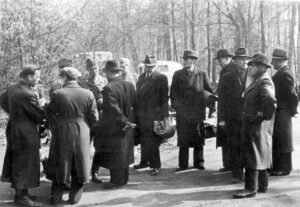 Being arrested is probably one of the scariest things that can happen to a person, especially when they have done nothing wrong. For most of us, that will never happen, but it could, if our government is corrupt and run by a dictator. Such was the case in Nazi Germany. After Hitler was elected, he began to dismantle the police department, filling it with men who were loyal to him. Then, he gave them unlimited authority to go after anyone who disagreed with his plan. These people were not guilty of any crime, they were simply on the wrong side of the political and spiritual agenda of the time.
Being arrested is probably one of the scariest things that can happen to a person, especially when they have done nothing wrong. For most of us, that will never happen, but it could, if our government is corrupt and run by a dictator. Such was the case in Nazi Germany. After Hitler was elected, he began to dismantle the police department, filling it with men who were loyal to him. Then, he gave them unlimited authority to go after anyone who disagreed with his plan. These people were not guilty of any crime, they were simply on the wrong side of the political and spiritual agenda of the time.
The Nazis set out to control every aspect of the lives of the people now under their control…making them little more than servants. It was a very dehumanizing system, whether the people were Jewish, Christian, Agnostic, or Atheist. Even the people who were in Hitler’s “good graces,” knew that one false move would end life as they knew it, or even get them killed. The Third Reich was the final authority in all things…at least at the time. The people were even subject to Hitler’s rules in the privacy of their own homes. The neighbors, and even some of their family members, became spies for the Third Reich. Once a “violation” was reported by anyone, the “perpetrator” was arrested, commonly in the middle of the night, hauled away, and often, never seen again. The Nazi leadership dramatically redefined the role of the police, giving them broad powers, completely independent of judicial review, to search, arrest, and incarcerate real or perceived state enemies and others they considered criminals.
Once a person was arrested, the police could do anything they chose to them to get them to talk…confess to their crimes. The victims of the police taken to Gestapo Headquarters where they were raped, beaten, tortured, enslaved, starved, and often killed, with no repercussions against the police at all. Their actions were considered above the law. They could even do those things to the people on the street, who were not under arrest for anything. The Supreme Court of that day, failed to challenge or protest the loss of judicial authority at this time. In general, it approved of the Nazi leadership’s decisive action. Further, the Supreme Court had been the court of first instance for treason cases since the Imperial period but, by the 1930s, it was overburdened with such trials and had endured relentless criticism from all sides for the judgments it rendered. The court was ultimately relieved to have responsibility for political crimes removed from its jurisdiction. It was another way to remove power from it’s proper place, and put it in the hands of the police, and ultimately Hitler.
The Secret State Police, called the Gestapo, which investigated political opposition, and the Criminal Police, called the Kripo, which handled all other types of criminal activity, were the two civilian forms of law enforcement officers. In addition, Hitler had the SS or the SA, which also imposed public order, but were considered paramilitary forces. The Gestapo was often used “protective custody” (Schutzhaft) to incarcerate people indefinitely, without specific charge or trial. These people were deemed to be potentially dangerous to the security of the Reich. Protective custody had been introduced in the German general law code before World War I to detain individuals for their own protection or to avert an immediate security threat if there were no other recourse. Do not be fooled by this. It was anything, but protective. The Gestapo employed protective custody to arrest political opponents at first, but later Jews, as well as Jehovah’s Witnesses who, because of religious conviction, refused to swear an oath to the Nazi German state or to serve in the armed forces. So, now the people could not speak out politically or religiously, and remember that their gun were also gone. It was a precarious place to be. Hitler was in charge, and he considered anyone who opposed him expendable.
So just imagine, you are asleep in your bed, after a nice Easter dinner with your family, and there comes a knock at the door…or rather a pounding at the door. The door bursts open and the police come in and drag your husband, wife, or even children away with barely a word spoken. No one was exempt. Kids could speak the 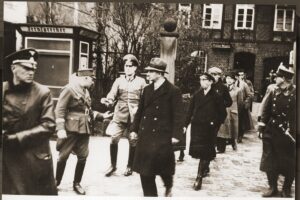
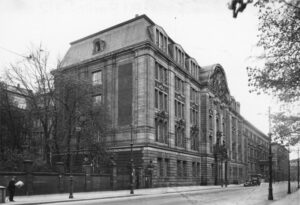 wrong things too. Of course, usually parents were the ones hauled away for what they taught the children. Children were taken into “protective custody” to be retrained in “proper” thinking…in other words, Nazism. Those were perilous times, and times that should never be forgotten. Failing to remember the horrors of the past, opens us up to a repetition of past mistakes in a future time.
wrong things too. Of course, usually parents were the ones hauled away for what they taught the children. Children were taken into “protective custody” to be retrained in “proper” thinking…in other words, Nazism. Those were perilous times, and times that should never be forgotten. Failing to remember the horrors of the past, opens us up to a repetition of past mistakes in a future time.
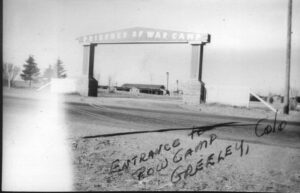 For some reason, when I think of Prisoner of War (POW) camps, I think of a place far away in a war zone, and there were some there, but as they filled up, the prisoners had to be moved to other areas. In addition to that, we needed men to work in the United States because our men were overseas fighting. The prisoners could be put to work in the fields to help grow needed foods for the country, as well as the troops. That idea was a bit foreign to me, especially when I heard that there was just such a camp that was practically in my backyard…even if I wasn’t born at the time. It’s just odd when history collides with your own neighborhood.
For some reason, when I think of Prisoner of War (POW) camps, I think of a place far away in a war zone, and there were some there, but as they filled up, the prisoners had to be moved to other areas. In addition to that, we needed men to work in the United States because our men were overseas fighting. The prisoners could be put to work in the fields to help grow needed foods for the country, as well as the troops. That idea was a bit foreign to me, especially when I heard that there was just such a camp that was practically in my backyard…even if I wasn’t born at the time. It’s just odd when history collides with your own neighborhood.
During World War II, the Greeley, Colorado POW camp had prisoners from Germany and Austria. The camp was built in 1943, and the first prisoners came in 1944. The camp was a self-contained town in itself. It had a fire station, hospital, theater, library, and classrooms. It also had electricity, water, and sewers. The prisoners who were held in the POW camps in the United States were treated well. This country wasn’t into the torture methods that the Axis of Evil nations were.

Many of the prisoners worked in the fields and paid money, for their labor, to take home with them. They were also given the chance to have fun. They had soccer teams. They dyed their t-shirts different colors using homemade dyes from vegetables. They had classes in English, German, and Mathematics. Some men were in the camp orchestra and others sang in choir. In many ways, the lives these men lived in the POW camps was better than the lives they lived at home…or at least during the war.
The Greeley POW Camp 202, was almost like a coveted assignment. It was the place the prisoners wanted to be sent. When new prisoners came to the camp, they would try to find men from their hometowns…hoping others had been as blessed as they felt to be there. The story is told that, “The old prisoners would toss out gum or paper with their names and address. One day a father and son found each other from the tossed notes.” These reunions were such a blessing for the prisoners. The guards were well liked. In fact, when one of the guards got married, the prisoners cooked their wedding night dinner for them. These good guards found favor with the prisoners.

I like to think that POW camps in and run by the United States were and are more civilized than those camps owned and run by other countries, but I don’t suppose all of them were run as compassionately as the Greeley POW Camp. We hear nightmare stories of Guantanamo Bay, and I’m sure there are others that weren’t so great. Still, I suppose things depend on the prisoners to a great degree. It is harder to show kindness to a prisoner who orchestrates a terrorist attack against our nation, killing thousands of innocent people, that it is to be compassionate to a soldier who is simply following orders, but is otherwise a kind and gentle person.
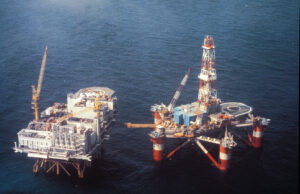 Apartment living is something many people do, and while they might dream of a house, or even have one, there can be reasons for having an apartment too. The oilfield would be one example of the need for a second place to live. Often, oil field workers must travel to the worksite. Once there, they have to stay there for a time, because traveling to and from home twice a day is just not feasible. Many oilfield companies provide living quarters for their employees. Sometimes it is a local motel, sometimes apartments, and sometimes, as with off shore drilling operations, companies must get innovative.
Apartment living is something many people do, and while they might dream of a house, or even have one, there can be reasons for having an apartment too. The oilfield would be one example of the need for a second place to live. Often, oil field workers must travel to the worksite. Once there, they have to stay there for a time, because traveling to and from home twice a day is just not feasible. Many oilfield companies provide living quarters for their employees. Sometimes it is a local motel, sometimes apartments, and sometimes, as with off shore drilling operations, companies must get innovative.
Some living quarters for oil field workers is quite a bit different than  others. The Edda oil rig in the Ekofisk field, 235 miles east of Dundee, Scotland had just such an unusual housing arrangement for the employees who worked on the Edda oil rig. The Alexander Kielland platform was a floating apartment unit that housed 208 people. The floating apartment complex was located in the North Sea. The majority of the Phillips Petroleum workers were from Norway, but a few were American and British. The platform was held up by two large pontoons. It had bedrooms, kitchens, and lounges, and provided a place for workers to spend their time when not working. It was truly a comfortable home away from home…for the most part.
others. The Edda oil rig in the Ekofisk field, 235 miles east of Dundee, Scotland had just such an unusual housing arrangement for the employees who worked on the Edda oil rig. The Alexander Kielland platform was a floating apartment unit that housed 208 people. The floating apartment complex was located in the North Sea. The majority of the Phillips Petroleum workers were from Norway, but a few were American and British. The platform was held up by two large pontoons. It had bedrooms, kitchens, and lounges, and provided a place for workers to spend their time when not working. It was truly a comfortable home away from home…for the most part.
On March 30, 1980, at about 6:30pm most of the residents were in the platform’s small theater watching a movie. There was a storm brewing, but although there were gale conditions in the North Sea that evening, no one was expecting that a large wave would collapse and capsize the platform. Everything happened very fast. 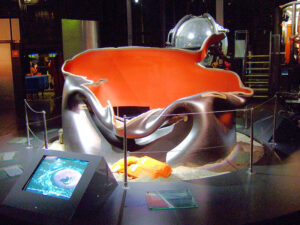 The wave hit, and things began to collapse. Within 15 minutes of the collapse, the floating apartment complex had capsized. It was so fast that many of the workers were unable to make it to the lifeboats. The Royal Air Force of Great Britain and Norwegian military both immediately sent rescue helicopters, but the poor weather made it impossible for them to help. Of the 208 people onboard, 123 drowned. The nightmare scenario seemed impossible, but a subsequent investigation revealed that there was a previously undetected crack in one of main legs of the platform. That had caused the structure’s disastrous collapse. The Alexander Kielland sat in the water for three years before it was salvaged.
The wave hit, and things began to collapse. Within 15 minutes of the collapse, the floating apartment complex had capsized. It was so fast that many of the workers were unable to make it to the lifeboats. The Royal Air Force of Great Britain and Norwegian military both immediately sent rescue helicopters, but the poor weather made it impossible for them to help. Of the 208 people onboard, 123 drowned. The nightmare scenario seemed impossible, but a subsequent investigation revealed that there was a previously undetected crack in one of main legs of the platform. That had caused the structure’s disastrous collapse. The Alexander Kielland sat in the water for three years before it was salvaged.
 These days, it seems we are hearing about mass shootings, terrorist-type attacks, bombings, and riots, all because people are “disgruntled” about something. It’s like everyone somehow thinks that the best solution to any disagreement is violence. Well, while this type of behavior is not new, it does seem to be happening more and more. Nevertheless, some of the worst attacks weren’t recent, but actually further back in our not so distant past.
These days, it seems we are hearing about mass shootings, terrorist-type attacks, bombings, and riots, all because people are “disgruntled” about something. It’s like everyone somehow thinks that the best solution to any disagreement is violence. Well, while this type of behavior is not new, it does seem to be happening more and more. Nevertheless, some of the worst attacks weren’t recent, but actually further back in our not so distant past.
On March 29, 1951, out of the blue, a homemade bomb exploded at Grand Central Station in New York City. While there were no injuries, commuters were quite startled. It wasn’t as easy to make a homemade bomb in 1951, because the internet didn’t exist. It’s not that the internet is the only place to find instructions on bombmaking, but it has made the process easier. Over the next few months, five more bombs were found at landmark sites around New York, including the public library. Authorities realized that this new wave of terrorist acts was the work of a man they dubbed the Mad Bomber.
This was not the first time New York had been visited by the so-called Mad Bomber. On November 16, 1940, a 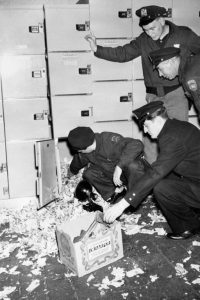 pipe bomb was left in the Edison building with a note that read, “Con Edison crooks, this is for you.” It was a clear indicator of a man who was “disgruntled” with Con Edison over something. What it was all about remained to be seen. Throughout 1941, more bombs were recovered , each more powerful than the last, until in December, the Mad Bomber sent a note stating, “I will make no more bomb units for the duration of the war.” What a strange turn of events. The Mad Bomber was…a patriot!! His letter also stated that Con Edison, New York’s electric utility company, would be brought to justice in due time. I’m not sure whether the people should have been praying for the war to continue, so that the bomber would stop bombing New York; or praying for the horrific war to come to an end. No matter what else he was, the Mad Bomber was not a liar. He made good on his promise, although he sent threatening notes to the press periodically. The year 1951 brought about a flurry of activity, then the Mad Bomber stopped again until 1954 when a bomb went off at Radio City Music Hall. Then in 1955, the Mad Bomber hit Grand Central Station, Macy’s, the RCA building, and the Staten Island Ferry.
pipe bomb was left in the Edison building with a note that read, “Con Edison crooks, this is for you.” It was a clear indicator of a man who was “disgruntled” with Con Edison over something. What it was all about remained to be seen. Throughout 1941, more bombs were recovered , each more powerful than the last, until in December, the Mad Bomber sent a note stating, “I will make no more bomb units for the duration of the war.” What a strange turn of events. The Mad Bomber was…a patriot!! His letter also stated that Con Edison, New York’s electric utility company, would be brought to justice in due time. I’m not sure whether the people should have been praying for the war to continue, so that the bomber would stop bombing New York; or praying for the horrific war to come to an end. No matter what else he was, the Mad Bomber was not a liar. He made good on his promise, although he sent threatening notes to the press periodically. The year 1951 brought about a flurry of activity, then the Mad Bomber stopped again until 1954 when a bomb went off at Radio City Music Hall. Then in 1955, the Mad Bomber hit Grand Central Station, Macy’s, the RCA building, and the Staten Island Ferry.
The police faced a stalemate when it came to finding the Mad Bomber, but finally, an investigative team working for Con Ed tracked him down. Looking through their employment records, they found that George Peter Metesky had been a disgruntled ex-employee since an accident in 1931. Metesky was furious that Con Ed refused to pay disability benefits and, in the end, resorted to terrorism as his revenge. This seems to be the  reason a lot of ex-employees resort to violence of some form. They think that because they were wronged, people must die to pay for the injustice they are feeling, never understanding that the people they injure or kill, were completely innocent in that matter. Really!! How dare they do such a thing?
reason a lot of ex-employees resort to violence of some form. They think that because they were wronged, people must die to pay for the injustice they are feeling, never understanding that the people they injure or kill, were completely innocent in that matter. Really!! How dare they do such a thing?
Metesky, had been a rather mild-mannered man, prior to the accident. It was his fury at his injustice that turned him into a monster. Metesky was found to be living with his sisters in Connecticut. Following his capture and trial, he was sent to a mental institution in April 1957 where he stayed until his release in 1973. He died in 1994.
 Tucked away in a sleepy area of Wyoming, lies an Old West outlaw hideout. It is located in a remote pass in the Big Horn Mountains of Johnson County, Wyoming. It’s called Hole-In-The-Wall, and in reality, it is anything, but a hole in a wall. The nearest town is Kaycee, Wyoming, population of 274. It is 24.9 miles away, but it will take you 53 minutes to get there by car.
Tucked away in a sleepy area of Wyoming, lies an Old West outlaw hideout. It is located in a remote pass in the Big Horn Mountains of Johnson County, Wyoming. It’s called Hole-In-The-Wall, and in reality, it is anything, but a hole in a wall. The nearest town is Kaycee, Wyoming, population of 274. It is 24.9 miles away, but it will take you 53 minutes to get there by car.
The hideout gets its name from the fact that there is a large break in an otherwise full wall of red sandstone. I suppose you could call it a hole in the wall, but it’s rather large to be called a hole. When I think of a hole in a wall, I picture a small hole…man-sized where a person could sneak in, and possibly even hide the hole with a tumbleweed, but that is not it at all. The remoteness of the area, and the wall made it almost impossible for lawmen to get to the hideout without being seen. The hideout was used 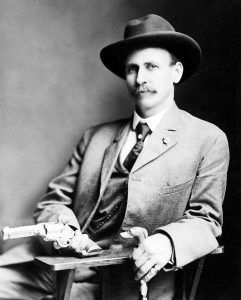 in the late 19th century by the Hole-in-the-Wall Gang, a group of cattle rustlers and other outlaws that included the Logan brothers, Kid Curry, Black Jack Ketchum, and Butch Cassidy’s Wild Bunch. Butch Cassidy, the Sundance Kid, and other desperados met at a log cabin in the Hole-in-the-Wall country. The cabin was built in 1883 by a man named Alexander Ghent.
in the late 19th century by the Hole-in-the-Wall Gang, a group of cattle rustlers and other outlaws that included the Logan brothers, Kid Curry, Black Jack Ketchum, and Butch Cassidy’s Wild Bunch. Butch Cassidy, the Sundance Kid, and other desperados met at a log cabin in the Hole-in-the-Wall country. The cabin was built in 1883 by a man named Alexander Ghent.
The lawmen tried a number of way to learn more about the site, including the one Pinkerton National Detective Agency detective, Charlie Siringo wrote about, “I started for the Big Horn Basin in the vicinity of the Hole-in-the-Wall in northern Wyoming. I had received instructions from Assistant Superintendent Curran to go up there and get in with the friends of the ‘Wild Bunch’, and learn their secrets.” He like so many more was unsuccessful. No lawmen ever successfully entered the Hole-In-The-Wall to capture outlaws during its more than fifty years of active existence, nor were any lawmen attempting to infiltrate it by use of undercover techniques successful.
The area was remote and secluded, easily defended because of its narrow passes, and impossible for lawmen to 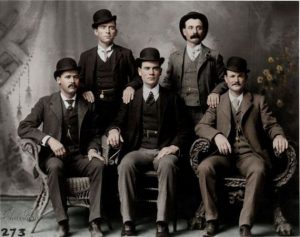 approach without alerting the outlaws. From the late 1860s to around 1910, the pass was used frequently by numerous outlaw gangs. At its height, it featured several cabins that gangs used to lie up during the harsh Wyoming winters, and it had a livery stable, corral, livestock, and supplies, with each gang contributing to the upkeep of the site. While several gangs were there at any given time, they were able to keep their plans and schemes to their own gang. I suppose the was some honor among thieves after all. Eventually, the use of this site faded into history, with gangs using it less frequently. Of course, now it is just another historic site, but some of the buildings are still there.
approach without alerting the outlaws. From the late 1860s to around 1910, the pass was used frequently by numerous outlaw gangs. At its height, it featured several cabins that gangs used to lie up during the harsh Wyoming winters, and it had a livery stable, corral, livestock, and supplies, with each gang contributing to the upkeep of the site. While several gangs were there at any given time, they were able to keep their plans and schemes to their own gang. I suppose the was some honor among thieves after all. Eventually, the use of this site faded into history, with gangs using it less frequently. Of course, now it is just another historic site, but some of the buildings are still there.
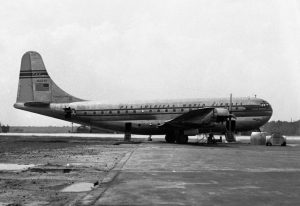 Pan American World Airways Flight 845/26, a Boeing 377 Stratocruiser, Clipper United States, N1032V departed from Seattle-Tacoma Airport (SeaTac) on March 26, 1955 at 8:15am…a Saturday morning, destined for Sydney, Australia, with stops at Portland, Oregon and Honolulu, Hawaii. Following its stop in Portland (PDX), the plane took off at 10:21am, with a crew of 8 and 15 passengers on board. It looked to be an easy flight to Hawaii, with plenty of onboard staff to make the trip enjoyable for the passengers. The plane was piloted by Captain Herman Joslyn, with First Officer Angus Gustavus Hendrick Jr; Second Officer Michael Kerwick; Flight Engineer Donald Read Fowler; and Assistant Flight Engineer Stuart Bachman. In the passenger cabin were Purser Natalie Parker, Stewardess Elizabeth Thompson, and Steward James Peppin.
Pan American World Airways Flight 845/26, a Boeing 377 Stratocruiser, Clipper United States, N1032V departed from Seattle-Tacoma Airport (SeaTac) on March 26, 1955 at 8:15am…a Saturday morning, destined for Sydney, Australia, with stops at Portland, Oregon and Honolulu, Hawaii. Following its stop in Portland (PDX), the plane took off at 10:21am, with a crew of 8 and 15 passengers on board. It looked to be an easy flight to Hawaii, with plenty of onboard staff to make the trip enjoyable for the passengers. The plane was piloted by Captain Herman Joslyn, with First Officer Angus Gustavus Hendrick Jr; Second Officer Michael Kerwick; Flight Engineer Donald Read Fowler; and Assistant Flight Engineer Stuart Bachman. In the passenger cabin were Purser Natalie Parker, Stewardess Elizabeth Thompson, and Steward James Peppin.
The flight was proceeding as normal, until it hit 10,000 feet, at which point a severe vibration lasting 5 to 8 seconds began. The Number 3 engine, which is on the right side, on the inside, suddenly ripped away from the starboard wing. The damage to the wing caused severe shaking. At the same time, the nose pitched down and the airspeed increased rapidly. Captain Joslyn immediately reduced engine power slow the plane down some, but they were losing altitude rapidly, quickly dropping by 5,000 feet. The damage cause by the engine ripping away included damage to the engines’ electrical system, and the flight engineer was not able to increase power on the remaining three engines. Without the added power on the remaining engines, the Stratocruiser was too heavy at this early stage in the flight to maintain its altitude. She still had too much fuel onboard to compensate. The Stratocruiser was doomed, and there was nowhere to land.
The flight crew ditched the Stratocruiser into the north Pacific Ocean at 11:12am, approximately 35 miles west of the Oregon coastline. The conditions were ideal for ditching, with smooth seas and little wind, but it was a hard impact. As the plane hit the water, seats were torn loose, and several occupants were injured. Nevertheless, no one was killed and evacuation began immediately with the inflation of all three life rafts. The water temperature was 47° F, so getting out of the water was essential. Soon after the crash, a North American Aviation F-86F Sabre flown by Captain W L Parks, 142nd Fighter Interceptor Group, Oregon Air National Guard, located the scene of the ditching. When he saw the smoke flares that had been released, he was able to see the two life rafts tied together. A Lockheed Constellation also rushed to the scene from the south. After confirming that Air Force rescue aircraft were on the way, Captain Parks returned to Portland, because he was low on fuel.
Among the injured was the airliner’s purser, Natalie Parker, who had been assisting passengers with their life vests and seat belts when the airliner hit the water. Because she was standing in the aisle, she was thrown forward, knocking down five rows of seats as she hit them. She was badly bruised and suffering from shock. Nevertheless, Parker assisted the passengers in abandoning the sinking Stratocruiser. When everyone was off, she enter the water and saw that some of the injured had begun to drift away. In an amazing act of bravery and duty, and suffering from shock, Parker swam out and towed the only seriously injured passenger to the nearest raft, some 200 feet away. The Stratocruiser floated for an amazing 20 minutes before sinking. While all survived the impact, four of the 23 persons on board, passengers John Peterson, David Darrow, First Officer Hendrick, and Flight Engineer Fowler, died of injuries and exposure. The survivors were rescued after two hours by the crew of USS Bayfield (APA-33), a United States Navy attack transport.
During the Civil Aeronautics Board hearings into the accident, Vice Chairman Joseph P. Adams commended Natalie Parker, the flight’s purser, “. . . all of us feel inspired that a fellow citizen, or just a fellow human being, can rise to such an occasion in the manner in which you did. It is most commendable, Miss Parker.” The exact cause of the loss of the Stratocruiser was not fully determined, because the engine and propeller were not recovered. Th investigation assumed that the most likely cause was a fracture of a propeller blade resulting in a severely unbalanced condition, causing the violent separation of the engine from the wing. This was the fifth time that a Boeing 377 Stratocruiser had lost an engine following the failure of a hollow-steel Hamilton Standard 2J17 propeller blade. Further complicating the matter, was the flight engineer’s attempt to increase the propeller rpm on the three engines simultaneously. That caused an electrical overload occurred which opened the master circuit breaker. This prevented any engine power increase, effectively bringing down the Stratocruiser.

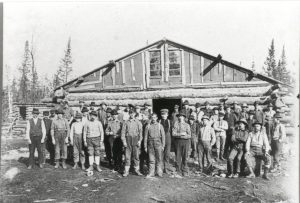 The port city of my birth, Superior, Wisconsin was founded on November 6, 1854 and incorporated March 25 1889. The city’s slogan soon became, “Where Sail Meets Rail,” because it was port connection between the shipping industry and the railroad. Much of Superior’s history parallels its sister city of Duluth’s, but Superior has been around longer than Duluth, which is also known as the Zenith City. Of course, the area had people there before that…there were Ojibwe Indians, and French traders that are known to be in the area in the early 1600s.
The port city of my birth, Superior, Wisconsin was founded on November 6, 1854 and incorporated March 25 1889. The city’s slogan soon became, “Where Sail Meets Rail,” because it was port connection between the shipping industry and the railroad. Much of Superior’s history parallels its sister city of Duluth’s, but Superior has been around longer than Duluth, which is also known as the Zenith City. Of course, the area had people there before that…there were Ojibwe Indians, and French traders that are known to be in the area in the early 1600s.
After the Ojibwe settled in the area and set up an encampment on present-day Madeline Island, the French started arriving. In 1618 voyageur Etienne Brulé paddled along Lake Superior’s south shore where he encountered the Ojibwe tribe, but he also found copper specimens. Brulé went back to Quebec with the copper samples, and a glowing report of the region. French traders and missionaries began settling the area a short time later, and a Lake Superior tributary was named for Brulé. Father Claude Jean Allouez, was one of those missionaries. His is often credited with the development of an early map of the region. Superior’s Allouez neighborhood takes its name from the Catholic missionary. The area was developed quickly after that, and by 1700 the area was crawling with French traders. The French traders developed a good working relationship with the Ojibwe people.
The Ojibwe continued to get along well with the French, but not so much the British, who ruled the area after 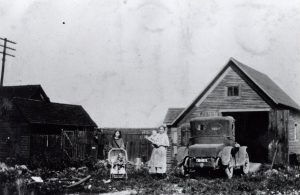
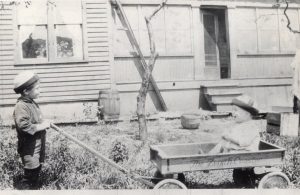 the French, but that ended with the America Revolution and the Treaty of Peace in 1783. The British weren’t as good to the Ojibwe as the French had been. Treaties with the Ojibwe would give more territory to settlers of European descent, and by 1847 the United States had taken control of all lands along Lake Superior’s south shore.
the French, but that ended with the America Revolution and the Treaty of Peace in 1783. The British weren’t as good to the Ojibwe as the French had been. Treaties with the Ojibwe would give more territory to settlers of European descent, and by 1847 the United States had taken control of all lands along Lake Superior’s south shore.
In 1854 the first copper claims were staked at the mouth of the Nemadji River…some say it was actually 1853. The Village of Superior became the county seat of the newly formed Douglas County that same year. The village grew quickly and within two years, about 2,500 people called Superior home. Unfortunately, with the financial panic of 1857, the town’s population stagnated through the end of the Civil War. The building of the Duluth Ship Canal in 1871, which was followed by the Panic of 1873. pretty much crushed Superior’s economic future. Things began to look up when in 1885, Robert Belknap and General John Henry Hammond’s Land and River Improvement Company established West Superior. Immediately they began building elevators, docks, and industrial railroads. In 1890, Superior City and West Superior merged, The city’s population fluctuated, as a boom town will, between 1887 and 1893, and then another financial panic halted progress. Over the years since then, Superior’s population has had it’s ups and down, as has it’s sister city, Duluth, but it has remained about one fourth the size of its twin across the bay.
My great grandparents, Carl and Albertine Schumacher lived in the Goodhue, Minnesota area, when my grandmother Anna was born, but my grandparents Allen and Anna Spencer lived in Superior. That is where my 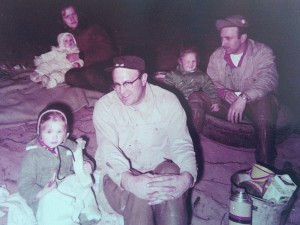
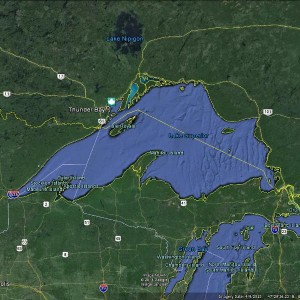 dad, Allen Spencer was born, as were my sister, Cheryl and I. We didn’t live in Superior for all of our lives, just 3 and 5 years, but the area remains in our blood, and in our hearts. It could be partly because of all the trips our family made back to Superior, but I don’t think that’s totally it, because there is just something about knowing that you came from a place, that will always make it special. Superior, Wisconsin is a very special place, that will always be a part of me and my sister, Cheryl too.
dad, Allen Spencer was born, as were my sister, Cheryl and I. We didn’t live in Superior for all of our lives, just 3 and 5 years, but the area remains in our blood, and in our hearts. It could be partly because of all the trips our family made back to Superior, but I don’t think that’s totally it, because there is just something about knowing that you came from a place, that will always make it special. Superior, Wisconsin is a very special place, that will always be a part of me and my sister, Cheryl too.
 As one who loves to hike, I am always interested in a new trail, whether I will ever get to hike that trail or not. The Chilkoot Trail is a 33 mile trail that travels through the Coast Mountains. The trail travels from Dyea, Alaska, in the United States, to Bennett, British Columbia, in Canada. During the Klondike Gold Rush (1896–1899), the Chilkoot Trail was transformed into a mainstream transportation route to Canada’s interior. The gold rush was primarily focused around Dawson City in Yukon and the Yukon River. While not the easiest trail, the Chilkoot Trail was the most direct, least expensive, and consequently the most popular.
As one who loves to hike, I am always interested in a new trail, whether I will ever get to hike that trail or not. The Chilkoot Trail is a 33 mile trail that travels through the Coast Mountains. The trail travels from Dyea, Alaska, in the United States, to Bennett, British Columbia, in Canada. During the Klondike Gold Rush (1896–1899), the Chilkoot Trail was transformed into a mainstream transportation route to Canada’s interior. The gold rush was primarily focused around Dawson City in Yukon and the Yukon River. While not the easiest trail, the Chilkoot Trail was the most direct, least expensive, and consequently the most popular.
The other primary route, the White Pass route based out of Skagway, was slightly longer but less rigorous and steep, whereas the Chilkoot was shorter and more difficult. Skagway, because of its deepwater harbor, served as the principal port for both routes…nearby Dyea, the beginning of the Chilkoot Trail, was built on the extensive, shallow Taiya River delta. Prospectors who chose the Chilkoot Trail were ferried to Dyea by small boat. The trails turned Skagway and Dyea into bustling tent cities during the gold rush years, which caused men from across the United States to leave their jobs 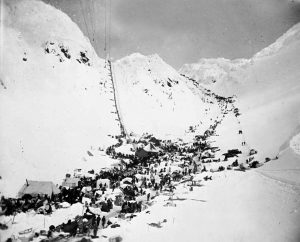 and family to travel up the Inside Passage to Skagway. They had gold on their minds, and the thought of going home rich was all they could think about. Most weren’t successful, and many didn’t make it there or back, but many went.
and family to travel up the Inside Passage to Skagway. They had gold on their minds, and the thought of going home rich was all they could think about. Most weren’t successful, and many didn’t make it there or back, but many went.
I don’t think this would be a trail I would want to be on in the winter, but it might be interesting in the summer months. There are many trails in the world that I would love to hike, but many of them I would probably only hike one time. I always find the history of the many trails that weren’t just for hiking originally, to be very interesting.

